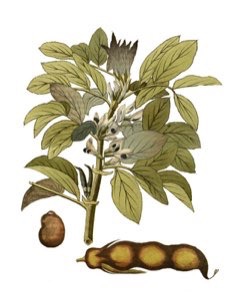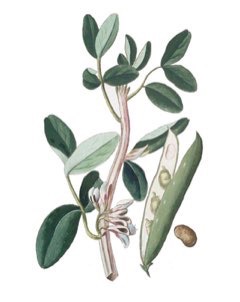 |
|
http://www.edibleplants.org |
 |
| http://www.edibleplants.org |
Translate this page:
Summary
Physical Characteristics

 Vicia faba is a ANNUAL growing to 1 m (3ft 3in) at a fast rate.
Vicia faba is a ANNUAL growing to 1 m (3ft 3in) at a fast rate.
See above for USDA hardiness. It is hardy to UK zone 5 and is not frost tender. It is in flower from May to August, and the seeds ripen from July to September. The species is hermaphrodite (has both male and female organs) and is pollinated by Bees. The plant is self-fertile.
It can fix Nitrogen.
Suitable for: light (sandy), medium (loamy) and heavy (clay) soils, prefers well-drained soil and can grow in heavy clay soil. Suitable pH: mildly acid, neutral and basic (mildly alkaline) soils. It can grow in semi-shade (light woodland) or no shade. It prefers moist soil. The plant can tolerates strong winds but not maritime exposure.
UK Hardiness Map
US Hardiness Map
Synonyms
Plant Habitats
Edible Uses
Seed - raw or cooked[27, 61]. It can be eaten before it is fully ripe in the same way as broad beans, the fully ripe seed requires overnight soaking to soften it before it is cooked. Leaves - cooked[105]. Used like spinach.
References More on Edible Uses
Medicinal Uses
Plants For A Future can not take any responsibility for any adverse effects from the use of plants. Always seek advice from a professional before using a plant medicinally.
None known
References More on Medicinal Uses
The Bookshop: Edible Plant Books
Our Latest books on Perennial Plants For Food Forests and Permaculture Gardens in paperback or digital formats.

Edible Tropical Plants
Food Forest Plants for Hotter Conditions: 250+ Plants For Tropical Food Forests & Permaculture Gardens.
More

Edible Temperate Plants
Plants for Your Food Forest: 500 Plants for Temperate Food Forests & Permaculture Gardens.
More

More Books
PFAF have eight books available in paperback and digital formats. Browse the shop for more information.
Shop Now
Other Uses
A good green manure crop, sown in autumn or spring. Relatively fast growing, producing a good bulk and fixing nitrogen[87]. The upright growth is not a very good weed suppresser though. A fibre is obtained from the stems. The burnt stems are rich in potassium and can be used in making soap.
Special Uses
Food Forest
References More on Other Uses
Cultivation details
Prefers a fairly heavy loam but succeeds in a sunny position in most soils that are well-drained[1]. Grows well in heavy clay soils. Dislikes dry conditions[57]. Sometimes cultivated for its edible seed, more commonly as a green manure crop[87]. There are 2 main types, 'daffa' beans are the more hardy and can be sown in the autumn, whilst 'tic' beans are best sown in spring. The autumn sown varieties are more susceptible to 'chocolate spot' fungus (which can be remedied by the addition of potash to the soil) but are more likely to escape damage from aphis[87]. This species has a symbiotic relationship with certain soil bacteria, these bacteria form nodules on the roots and fix atmospheric nitrogen. Some of this nitrogen is utilized by the growing plant but some can also be used by other plants growing nearby[200]. When removing plant remains at the end of the growing season, it is best to only remove the aerial parts of the plant, leaving the roots in the ground to decay and release their nitrogen.
References Carbon Farming Information and Carbon Sequestration Information
Temperature Converter
Type a value in the Celsius field to convert the value to Fahrenheit:
Fahrenheit:
The PFAF Bookshop
Plants For A Future have a number of books available in paperback and digital form. Book titles include Edible Plants, Edible Perennials, Edible Trees,Edible Shrubs, Woodland Gardening, and Temperate Food Forest Plants. Our new book is Food Forest Plants For Hotter Conditions (Tropical and Sub-Tropical).
Shop Now
Plant Propagation
Pre-soak the seed for 24 hours in warm water and then sow in situ in spring or autumn.
Other Names
If available other names are mentioned here
Native Range
(Vicia faba) Afghanistan, Iran.
Weed Potential
Right plant wrong place. We are currently updating this section.
Please note that a plant may be invasive in one area but may not in your area so it's worth checking.
Conservation Status
IUCN Red List of Threatened Plants Status :

| Related Plants
|
| Latin Name | Common Name | Habit | Height | Hardiness | Growth | Soil | Shade | Moisture | Edible | Medicinal | Other |
| Artemisia ludoviciana | White Sage, Louisiana Sage, Prairie Sage, Western Mugwort | Perennial | 1.0 |
3-9
| M | LM | SN | DM | 2 | 2 | 2 |
| Artemisia ludoviciana gnaphalodes | White Sage | Perennial | 1.0 |
4-8
| | LM | SN | DM | 0 | 2 | 1 |
| Avena ludoviciana | Oats | Annual | 0.0 |
-
| | LMH | N | DM | 2 | 0 | 2 |
| Lactuca ludoviciana | Western Wild Lettuce, Biannual lettuce | Biennial | 1.2 |
0-0
| | LM | SN | M | 2 | 2 | |
| Orobanche ludoviciana | Broomrape, Louisiana broomrape | Perennial | 1.5 |
0-0
| | LMH | FSN | M | 1 | 1 | 0 |
| Vicia americana | American Vetch, Mat vetch | Perennial | 1.0 |
4-7
| | LMH | SN | M | 2 | 1 | 4 |
| Vicia amoena | | Perennial | 1.0 |
-
| | LMH | SN | M | 1 | 0 | |
| Vicia amurensis | | Perennial | 1.5 |
-
| | LMH | SN | M | 1 | 0 | |
| Vicia articulata | One-Flower Vetch | Annual | 0.6 |
-
| | LMH | SN | M | 1 | 0 | 3 |
| Vicia benghalensis | Purple Vetch | Annual/Perennial | 0.6 |
-
| F | LMH | SN | M | 0 | 0 | 3 |
| Vicia caroliniana | Carolina vetch, Carolina wood vetch | Perennial | 0.6 |
3-9
| M | LMH | FSN | M | 0 | 2 | 4 |
| Vicia cracca | Tufted Vetch, Bird vetch, Cow vetch | Perennial Climber | 1.8 |
4-8
| | LMH | SN | M | 1 | 1 | 3 |
| Vicia ervilia | Bitter Vetch | Annual | 0.6 |
-
| | LMH | SN | M | 1 | 0 | |
| Vicia faba equina | Horsebean | Annual | 1.0 |
4-8
| F | LMH | SN | M | 3 | 0 | 3 |
| Vicia faba major | Broad Bean, Fava Bean | Annual | 1.0 |
4-10
| F | LMH | SN | M | 4 | 1 | 3 |
| Vicia faba minuta | Tick Bean | Annual | 1.0 |
4-8
| F | LMH | SN | M | 3 | 0 | 3 |
| Vicia gigantea | Giant Vetch | Perennial | 1.0 |
4-8
| | LMH | SN | M | 2 | 1 | 3 |
| Vicia grandiflora kitaibeliana | large yellow vetch | Annual | 0.0 |
-
| | LMH | SN | M | 2 | 0 | |
| Vicia heptajuga | | Perennial | 0.0 |
-
| | LMH | SN | M | 1 | 0 | |
| Vicia hirsuta | Hairy Tare, Tiny vetch | Annual | 0.5 |
4-9
| | LMH | SN | M | 2 | 0 | 3 |
| Vicia hirticalycina | | Perennial | 0.0 |
-
| | LMH | SN | M | 1 | 0 | |
| Vicia japonica | | Perennial | 1.5 |
-
| | LMH | SN | M | 1 | 0 | |
| Vicia monantha | Hard Vetch, Barn vetch | Annual | 0.0 |
0-0
| | LMH | SN | M | 2 | 0 | 3 |
| Vicia narbonensis | French Vetch, Purple broad vetch | Annual | 1.0 |
0-0
| | LMH | SN | M | 2 | 0 | |
| Vicia nipponica | | Perennial | 0.8 |
-
| | LMH | SN | M | 1 | 0 | |
| Vicia noeana | | Annual | 0.6 |
-
| | LMH | SN | M | 1 | 0 | |
| Vicia pisiformis | Pea Vetch, Pale-flower vetch | Perennial | 1.8 |
0-0
| | LMH | SN | M | 1 | 0 | |
| Vicia pseudo-orobus | | Perennial | 1.5 |
-
| | LMH | SN | DM | 1 | 0 | |
| Vicia sativa | Winter Tares, Garden vetch, Subterranean vetch | Annual Climber | 1.2 |
4-8
| F | LMH | SN | M | 3 | 0 | 3 |
| Vicia sativa leucosperma | Winter Tares | Annual Climber | 1.2 |
4-8
| F | LMH | SN | M | 3 | 0 | 3 |
|
|
Growth: S = slow M = medium F = fast. Soil: L = light (sandy) M = medium H = heavy (clay). pH: A = acid N = neutral B = basic (alkaline). Shade: F = full shade S = semi-shade N = no shade. Moisture: D = dry M = Moist We = wet Wa = water.
Now available:
Food Forest Plants for Mediterranean Conditions
350+ Perennial Plants For Mediterranean and Drier Food Forests and Permaculture Gardens.
[Paperback and eBook]
This is the third in Plants For A Future's series of plant guides for food forests tailored to
specific climate zones. Following volumes on temperate and tropical ecosystems, this book focuses
on species suited to Mediterranean conditions—regions with hot, dry summers and cool, wet winters,
often facing the added challenge of climate change.
Read More
Expert comment
Author
Pers.
Botanical References
17100
Links / References
For a list of references used on this page please go here
Readers comment
| Add a comment |
|
If you have important information about this plant that may help other users please add a comment or link below. Only comments or links that are felt to be directly relevant to a plant will be included. If you think a comment/link or information contained on this page is inaccurate or misleading we would welcome your feedback at [email protected]. If you have questions about a plant please use the Forum on this website as we do not have the resources to answer questions ourselves.
* Please note: the comments by website users are not necessarily those held by PFAF and may give misleading or inaccurate information.
To leave a comment please Register or login here All comments need to be approved so will not appear immediately.
|
|